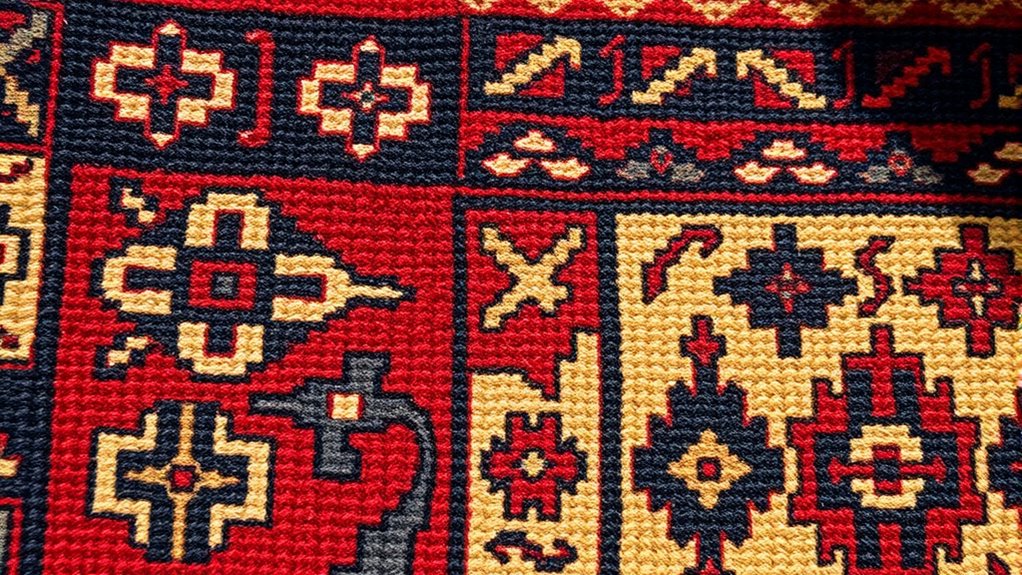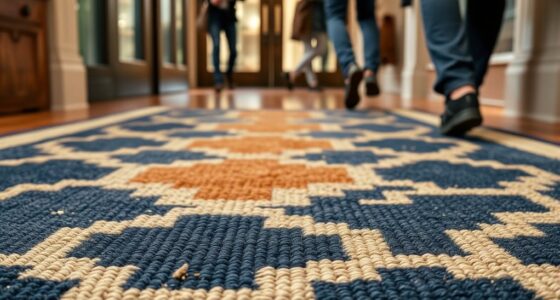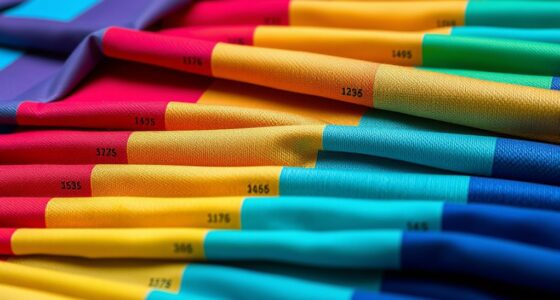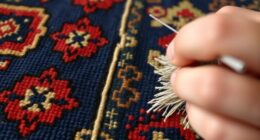Antique Caucasian rugs tell stories through their bold geometric patterns, each symbol meaning something important in the culture. You’ll see motifs like protection hooks, stars, and trees, often dyed in vibrant colors such as red and blue to boost their symbolism. These patterns reflect community beliefs, history, and spiritual values. If you explore further, you’ll uncover the rich messages woven into each design and their cultural significance.
Key Takeaways
- Symbols like hooks, stars, and eye motifs represent protection, guidance, and spiritual beliefs in Caucasian rug designs.
- Natural dyes such as red, blue, and white convey vitality, protection, and purity, adding symbolic meaning.
- Traditional weaving techniques ensure sharp, bold motifs, preserving cultural stories and tribal identities.
- Patterns reflect community histories, beliefs, and social values, serving as visual storytelling.
- Preservation of antique rugs involves expert restoration and proper storage to maintain their cultural and symbolic integrity.
The Geometric Language of Caucasian Rugs
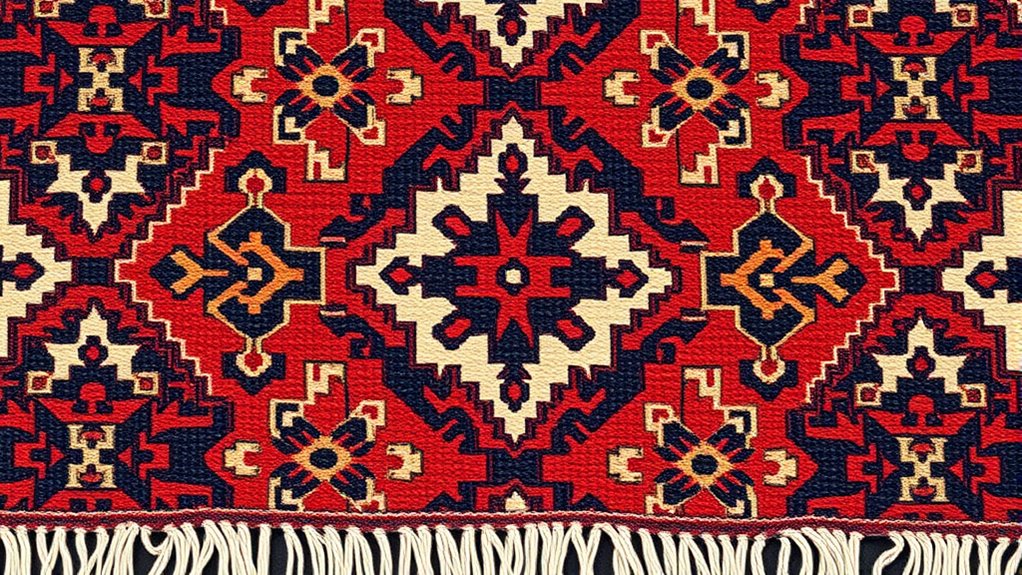
The geometric patterns of Caucasian rugs serve as a visual language that conveys meaning and cultural identity. You’ll notice that their intricate designs are created through specific weaving techniques that require skill and precision, often involving symmetrical knotting and tight weaving. These techniques help preserve sharp lines and bold shapes that define the patterns. Additionally, dyeing methods play a vital role in achieving vibrant, long-lasting colors. Natural dyes derived from plants, insects, and minerals are carefully applied to produce rich reds, blues, and browns, enhancing the geometric motifs. Weaving techniques contribute to the durability and distinctiveness of the patterns, ensuring they remain a vital part of cultural expression. Together, these weaving and dyeing methods contribute to the distinctive look of Caucasian rugs, making their patterns not just decorative but also a cultural code passed down through generations.
Common Motifs and Their Meanings
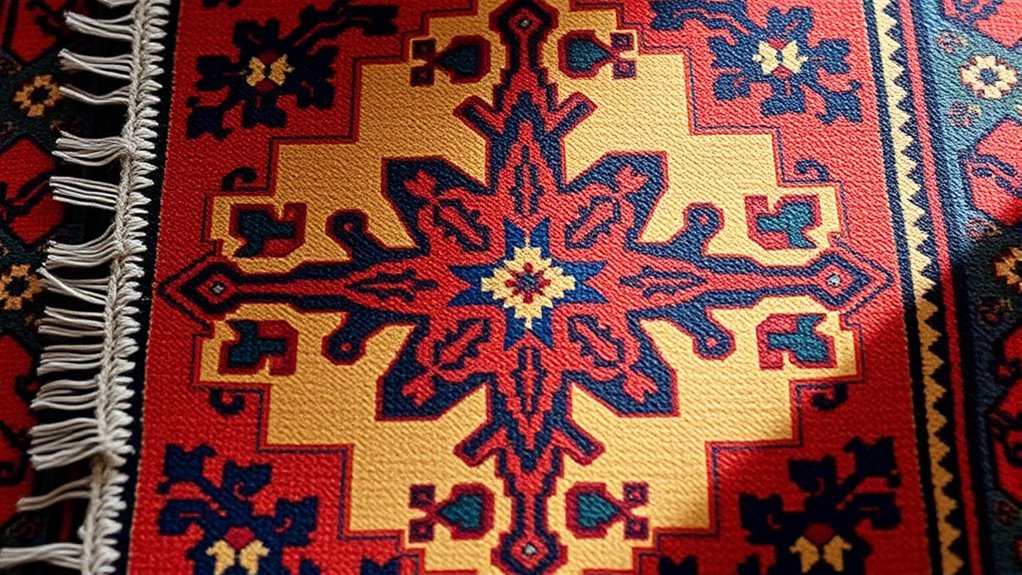
Many Caucasian rugs feature motifs that carry specific symbolic meanings, serving as visual stories rooted in tradition. These symbols often reflect cultural beliefs, nature, or protective qualities. The weaving techniques used influence how motifs are formed, with intricate knotting and precise patterns highlighting their significance. Dyeing methods also play a role, with natural dyes creating vibrant contrasts that emphasize particular symbols. For example, a hooked motif might symbolize protection, while a star pattern could represent guidance. As you examine a rug, consider how the motifs are woven and dyed; these craftsmanship details convey deeper stories and cultural values. Recognizing these motifs helps you appreciate the rich symbolism embedded in each rug, transforming it from mere decoration into a narrative of heritage. Additionally, the dyeing techniques used can indicate the rug’s origin and historical period, adding another layer of meaning to its design.
Cultural Influences Reflected in Patterns

Cultural influences shape the patterns found in Caucasian rugs, reflecting the unique histories, beliefs, and social values of different communities. You’ll notice how weaving techniques vary, with each group using specific methods that influence the rug’s texture and design. These techniques often carry cultural significance, revealing traditional craftsmanship passed down through generations. Dye symbolism also plays an essential role; natural dyes are chosen for their colors, which hold particular meanings—red for vitality, blue for protection, and white for purity. These choices aren’t random but deeply rooted in cultural identity. Understanding weaving techniques can further enhance appreciation of the craftsmanship and cultural storytelling behind each rug. By examining the patterns, weaving methods, and dye symbolism, you gain insight into the community’s worldview and history, making each rug a layered story of cultural expression.
Symbolism and Spiritual Significance
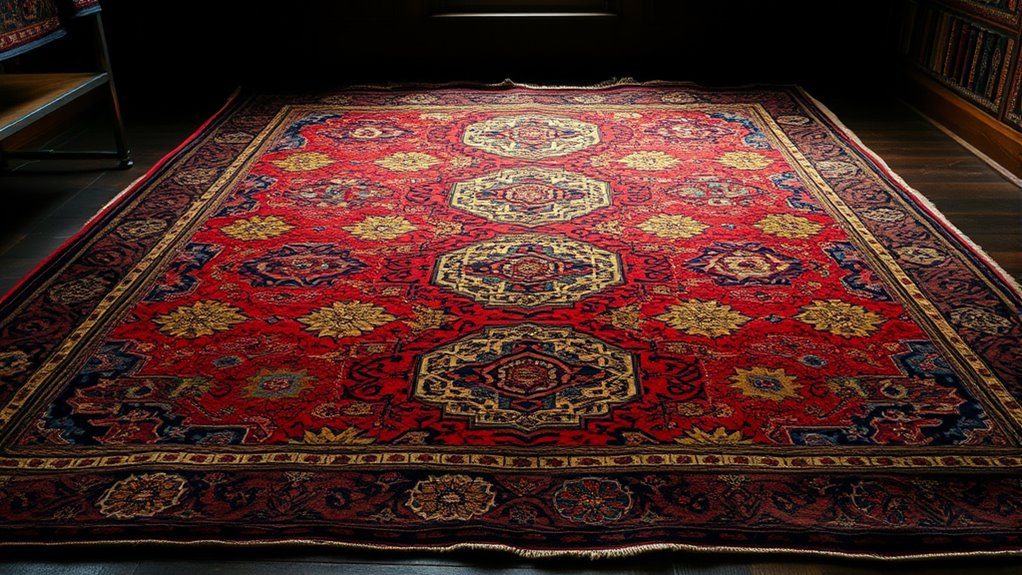
Patterns and dyes in Caucasian rugs do more than decorate; they serve as symbols carrying spiritual meanings. You’ll notice that tribal symbolism reflects beliefs, protection, and identity, often woven into the designs. These symbols act as talismans, warding off evil or inviting blessings. The colors also hold spiritual significance—red signifies vitality, while blue represents protection. Here’s a glimpse of common symbols:
| Symbol | Meaning |
|---|---|
| Eye motifs | Spiritual protection |
| Star patterns | Guidance and hope |
| Ram’s horns | Strength and fertility |
| Crosses | Faith and protection |
| Tree of Life | Connection to spiritual domains |
Understanding these symbols deepens your appreciation of the rug’s spiritual symbolism and tribal roots. Recognizing the symbolic meanings embedded in the designs enhances the cultural value and spiritual connection of these exquisite textiles.
Preservation and the Legacy of Traditional Craftsmanship

Have you ever wondered how traditional craftsmanship keeps the vibrant history of Caucasian rugs alive today? Preservation relies on expert restoration techniques that respect the rug’s original materials and designs. Proper cleaning, repairing worn fibers, and stabilizing fragile areas help maintain their integrity without compromising authenticity. As a collector, your tips include storing rugs away from direct sunlight and humidity, which can cause deterioration. Learning about traditional dyeing and weaving methods ensures you recognize authentic craftsmanship and avoid fakes. Supporting artisans who continue these skills helps preserve this cultural legacy. By understanding these preservation strategies, you protect the stories woven into each rug, ensuring future generations can appreciate their rich symbolism and artistry. Additionally, familiarizing yourself with traditional dyeing techniques can help identify genuine Caucasian rugs and prevent the inadvertent acquisition of counterfeit pieces. Your care sustains not just a textile but an essential piece of Caucasian heritage.
Frequently Asked Questions
How Can I Authenticate an Antique Caucasian Rug’s Age and Origin?
To authenticate an antique Caucasian rug’s age and origin, start by examining its knot density and weaving style, which vary by region and period. Conduct dye analysis to determine if natural dyes were used, indicating age and authenticity. Look for consistent, traditional patterns and signs of wear. Consulting a professional appraiser who specializes in Caucasian rugs can also provide expert validation of its age and origin.
What Are the Most Rare and Valuable Caucasian Rug Motifs?
You might find it surprising, but some Caucasian rug motifs hold extraordinary rarity and value. Motif symbolism often reflects cultural significance, with unique designs like the “Tree of Life” or “Runic Symbols” standing out. These rare motifs evoke deep stories and traditions, making the rug not just a decorative piece but a treasured artifact. Recognizing these patterns helps you appreciate their historical importance and can considerably enhance your collection’s worth.
How Do Environmental Factors Affect the Preservation of These Rugs?
You should consider how climate impact affects your antique Caucasian rugs, as high humidity can lead to mold and fiber deterioration, while dry conditions may cause fibers to become brittle. Pest prevention is essential; pests like moths can damage the textiles. Keep your rugs in a stable environment with controlled temperature and humidity, and regularly inspect them to prevent damage, ensuring your rugs stay vibrant and intact for years to come.
Are There Modern Reproductions That Mimic Traditional Caucasian Designs?
Imagine a mirror reflecting a master’s brushstroke; modern reproductions are just that—faithful design imitations of traditional Caucasian rugs. You’ll find many modern reproductions that mimic authentic patterns, capturing the intricate geometry and storytelling essence. These pieces serve as visual echoes of history, offering affordable, stylish options. While they don’t carry the same soul, they celebrate the artistry, allowing you to enjoy the beauty of Caucasian designs in your space today.
What Is the Best Way to Care for and Restore Antique Caucasian Rugs?
To care for and restore your antique Caucasian rug, start with gentle cleaning methods like vacuuming regularly without a beater bar, and avoid harsh chemicals. When necessary, use professional restoration techniques such as patching, reweaving, or dyeing by experienced conservators. This helps preserve its value and beauty. Always consult a specialist for delicate repairs, ensuring your rug stays vibrant and intact for years to come.
Conclusion
As you explore antique Caucasian rugs, you unfasten stories woven into every knot and pattern—each one a whisper from the past. These symbols and motifs aren’t just designs; they’re echoes of cultural identity, spirituality, and tradition. By appreciating their craftsmanship, you become part of their legacy, preserving a rich heritage that transcends time. Isn’t it incredible how a single rug can hold a universe of meaning—waiting for you to discover it?
